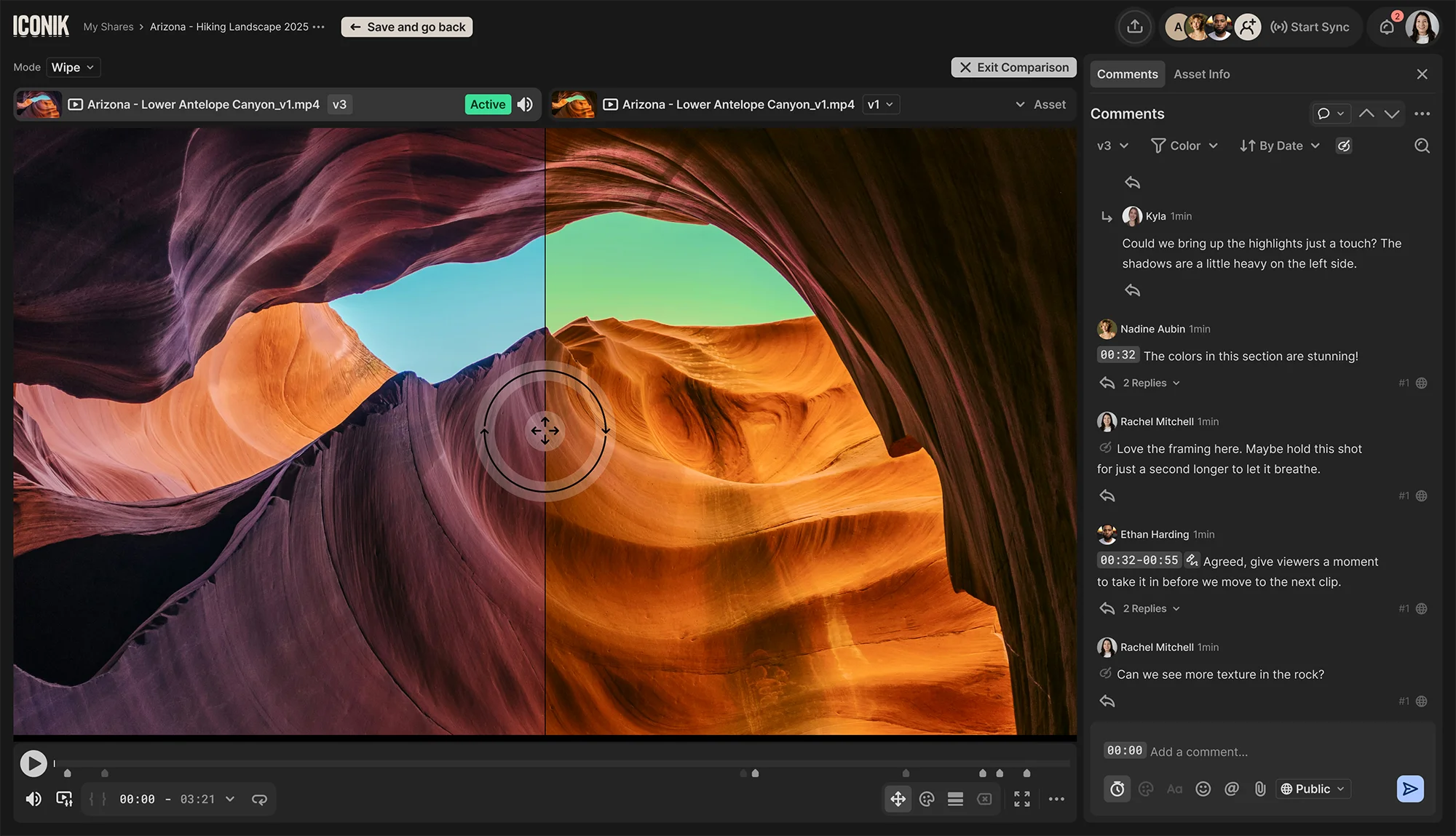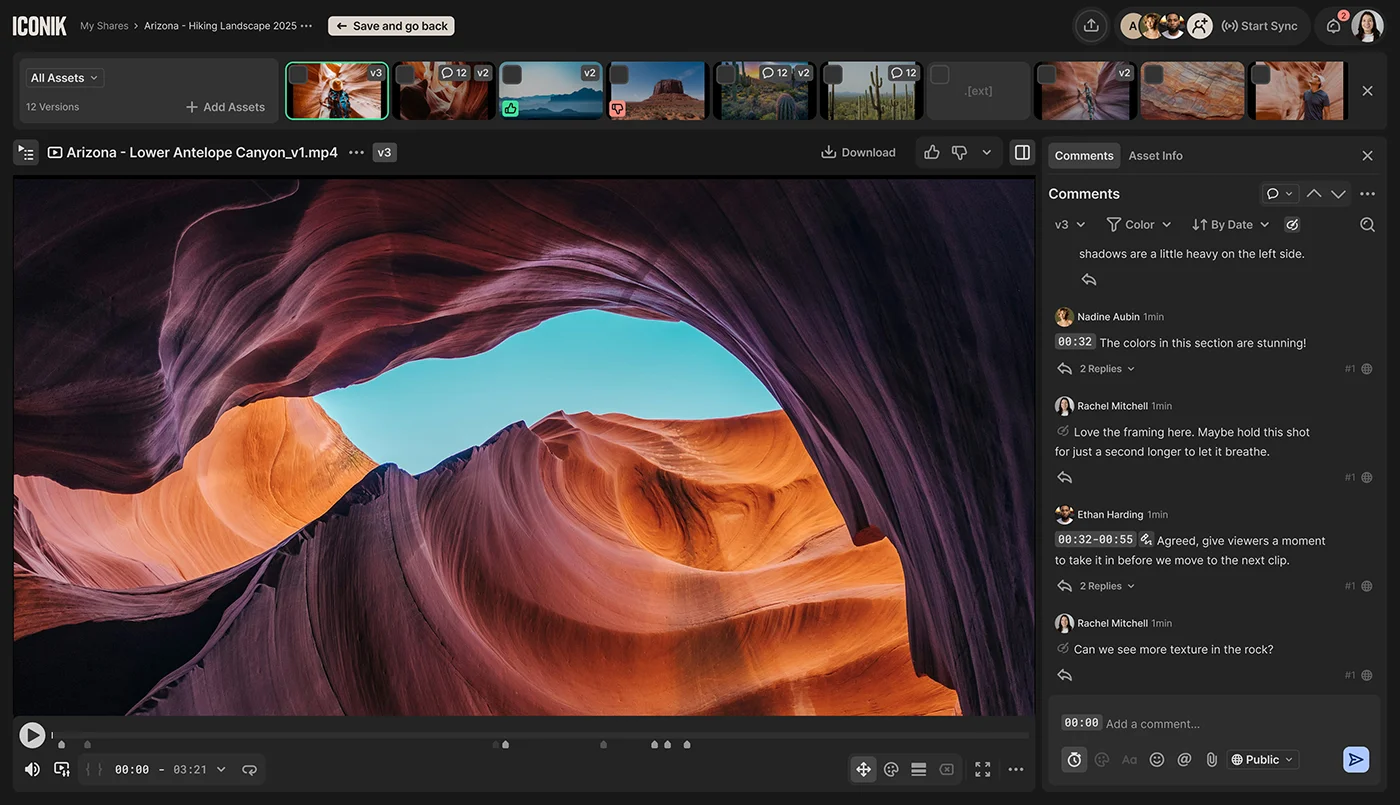Iconik vs. Shade: Which is right for global creative teams?
The right media asset management (MAM) platform is simple enough to use from day one, but also comes equipped with the features and integrations that allow your team to grow. Iconik provides enterprise-grade infrastructure that scales with complex production environments. While enterprise features might seem excessive early on, they become strategic advantages as operations mature—transforming media management from reactive firefighting into predictable systems that reduce costs and accelerate delivery.
This comparison examines where each platform excels and helps you determine which approach aligns with where you are today—and where you're heading tomorrow.
Scale isn't just about size—it's about operational maturity
Iconik powers broadcasters and studios managing millions of assets across distributed teams. Our hybrid storage support connects cloud, NAS, and SAN infrastructure. Automated lifecycle management reduces storage costs by intelligently tiering assets. API-first architecture enables workflow automation that eliminates manual overhead.
Shade focuses on simplicity for smaller operations. S3-compatible storage keeps infrastructure straightforward. Built-in AI capabilities reduce manual tagging effort. The platform gets teams productive quickly without extensive configuration.

Real-time review vs. async commenting: Different collaboration models
How teams review content shapes delivery timelines.
Iconik's synchronized collaboration
Synchronized review sessions let distributed teams see identical frames simultaneously. Side-by-side version comparison with master-quality playback helps stakeholders evaluate revisions. Frame-accurate annotations with integrated approval workflows create clear decision trails. When productions involve multiple stakeholders across time zones making time-sensitive decisions, synchronized sessions compress feedback cycles.
Shade's asynchronous approach
Time-stamped, frame-accurate commenting with pinned annotations and threaded replies supports flexible feedback. @mentions and comment completion states help teams track resolution. This async model works well for small teams where review happens at different times and real-time alignment isn't critical.
Choosing your model: Synchronized review accelerates delivery when multiple stakeholders need to align quickly. Async commenting provides flexibility when teams work across different schedules without tight coordination requirements.
Feature depth: Where platforms specialize
Collaboration and review
Iconik provides synchronized multi-user sessions, side-by-side version comparison, and integrated approval workflows with audit trails. Teams needing real-time alignment and version control get purpose-built tools for those workflows.
Shade offers time-stamped commenting, threaded replies, and @mentions for async collaboration. The model suits teams where feedback happens asynchronously without requiring synchronized sessions.
Storage options
Iconik: Hybrid flexibility with lifecycle automation
Iconik connects to cloud, NAS, SAN, and any S3-compatible provider through the Iconik Storage Gateway. Automated lifecycle tiering moves assets between hot/warm/cold/archive tiers based on policies you define—age, usage patterns, or metadata values. Organizations with large archives see measurable storage cost reductions as inactive content automatically moves to cost-effective tiers.
Shade: S3-compatible cloud and self-hosted
Shade works with AWS, GCP, Wasabi, Backblaze, and self-hosted MinIO through a BYOS3 model. Virtual NAS through ShadeFS supports streaming and caching. The approach keeps storage architecture straightforward for teams working primarily in cloud environments.
The practical difference
Automated lifecycle management becomes valuable as archives grow. Without it, storage costs scale linearly with asset volume.
Enterprise-grade security and scale
Iconik's infrastructure
API-first architecture means every UI feature maps to an API endpoint. Built-in orchestration engine automates complex pipelines. Professional transcoder integrations (Vantage, Hiscale) support advanced workflows. SSO/SAML/OAuth authentication with granular ACLs addresses enterprise security requirements. The platform handles petabyte-scale deployments with multi-region redundancy.
Shade's developing capabilities
RESTful API with Python SDK and webhook support enables custom integrations. Multipart uploads support files up to 5TB. API keys inherit user permissions for access control. The platform focuses on accessibility over complex enterprise infrastructure.
Where this matters
As operations scale, automation reduces manual overhead. Teams managing complex workflows across multiple systems benefit from deep integration capabilities and mature orchestration tools.
AI and metadata: Different philosophies
Both platforms use AI to reduce manual effort, but take different approaches to metadata governance.
Shade's AI-first model
Multiple AI capabilities—transcription, facial recognition, color analysis, object detection—help teams tag content automatically. The approach emphasizes getting value from AI quickly without extensive configuration.
Iconik's integrated approach
AI reduces manual effort through transcription, facial recognition, and object detection. Open integration with multiple providers (Google, AWS, Rev.ai) gives flexibility to choose based on cost, compliance, and regional requirements. Bring your own AI accounts to manage costs directly.
Structured metadata governance works alongside AI. Hierarchical categories, custom fields, and inheritance controls ensure consistency. This matters when metadata drives rights management, compliance tracking, and automated workflows—use cases where precision and auditability are critical.
Choosing your approach
AI-first workflows get teams productive quickly. Structured governance becomes valuable when metadata needs to support complex rights management, compliance requirements, or automated business logic.

Choosing your best asset management model
Shade works well when you:
- Run a small team or freelance operation
- Work primarily with S3-compatible storage
- Value simplicity and quick deployment
- Use async collaboration without real-time coordination needs
- Want AI-driven workflows without extensive configuration
Iconik works well when you:
- Manage distributed teams across complex production workflows
- Need hybrid storage flexibility with existing infrastructure
- Require synchronized review and integrated approval processes
- Operate under compliance requirements demanding audit trails
- Want workflow automation that eliminates manual overhead
- Need proven reliability at scale
The platform decision reflects operational reality. Small teams benefit from tools that emphasize simplicity and quick value. Complex production environments need infrastructure that supports scale, governance, and integration with existing systems.
See how Iconik works for your workflows
Request a Demo — Talk with our team about your specific requirements.
Start Free Trial — Get hands-on immediately. Full features, no credit card required.
.svg)





